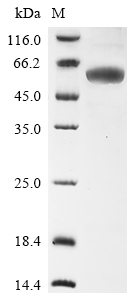Recombinant Human Fructose-bisphosphate aldolase A (ALDOA) is produced in E. coli and contains the complete mature protein sequence spanning amino acids 2 to 364. The protein includes an N-terminal 6xHis-tag, which makes purification and detection more straightforward. SDS-PAGE analysis confirms the product achieves greater than 85% purity. It's designed strictly for research purposes, with endotoxin levels carefully monitored to meet the requirements of different experimental setups.
In glycolysis, Fructose-bisphosphate aldolase A (ALDOA) appears to serve a fundamental function by catalyzing the reversible breakdown of fructose-1,6-bisphosphate into glyceraldehyde-3-phosphate and dihydroxyacetone phosphate. Energy production in cells seems to depend heavily on this enzyme, particularly in tissues like muscle and brain where energy demands run high. Scientists often focus on ALDOA when investigating how metabolic pathways operate and how energy gets regulated at the cellular level.
Potential Applications
Note: The applications listed below are based on what we know about this protein's biological functions, published research, and experience from experts in the field. However, we haven't fully tested all of these applications ourselves yet. We'd recommend running some preliminary tests first to make sure they work for your specific research goals.
The use of an E. coli expression system for a human metabolic enzyme like ALDOA poses significant risks to proper folding and bioactivity. ALDOA's functional activity depends on precise tertiary structure and tetramer formation. While E. coli is a common host for recombinant protein production due to its cost-effectiveness and high yield, it lacks the eukaryotic chaperones and post-translational modification machinery necessary for optimal folding of human proteins. The N-terminal 6xHis tag, though useful for purification, could sterically interfere with the protein's N-terminal region, potentially affecting its folding, oligomerization, or active site accessibility. Studies have shown that recombinant proteins expressed in E. coli, even with high solubility, can form soluble aggregates that are misfolded and inactive. While it is possible that the protein could be correctly folded, the absence of validation data means it cannot be assumed to be bioactive. Experimental verification is essential before any functional application.
1. Glycolytic Pathway Enzyme Activity Studies
This recombinant ALDOA protein could be used for enzyme activity studies only if its folding and bioactivity are experimentally verified. The full-length sequence is necessary for function, and the His-tag facilitates purification. However, if the protein is misfolded or improperly oligomerized, measurements of kinetic parameters (e.g., Km, Vmax) or substrate specificity may be inaccurate or meaningless. The E. coli expression system may not support the correct quaternary structure (ALDOA functions as a tetramer), which is critical for activity. Without validation via an enzymatic activity assay (e.g., using fructose-1,6-bisphosphate as a substrate), this application risks generating misleading data.
2. Antibody Development and Validation
This recombinant ALDOA protein is suitable as an immunogen for generating antibodies targeting linear epitopes, as antibody production primarily relies on amino acid sequences rather than native conformation. The high purity (>85%) reduces the risk of antibodies against contaminants. However, if the protein is misfolded, antibodies generated may not recognize the native, functionally active ALDOA in physiological contexts (e.g., in immunofluorescence or Western blot under non-denaturing conditions), especially if conformational epitopes are critical. The His-tag could also induce tag-specific antibodies, requiring careful screening.
3. Protein-Protein Interaction Studies
The His-tagged protein can be used technically in pull-down assays to screen for interaction partners. However, the biological relevance of any identified interactions is highly dependent on correct folding. Misfolding could alter binding interfaces, leading to non-physiological interactions (false positives) or failure to bind genuine partners (false negatives). ALDOA is known to interact with other proteins in metabolic pathways; thus, using a misfolded version may compromise the validity of results. Any interactions must be confirmed with native ALDOA from human cells or tissues.
4. Structural and Biophysical Characterization
The protein's suitability for structural studies (e.g., X-ray crystallography) is strictly dependent on proper folding, homogeneity, and correct oligomeric state. Techniques like circular dichroism or dynamic light scattering could be applied, but data from a misfolded protein would not reflect the native structure. The N-terminal His-tag might interfere with crystal packing or NMR analysis. Prior validation using size-exclusion chromatography (to check tetramer formation) and biophysical assays is essential to ensure meaningful results.
5. Metabolic Pathway Reconstitution Assays
This application is fully contingent on confirmed bioactivity. Reconstituting glycolytic pathways requires enzymatically active ALDOA to accurately model metabolic flux and regulation. If the recombinant protein is inactive due to misfolding, it would disrupt pathway efficiency and lead to incorrect conclusions about metabolic control. The enzyme must first be validated for specific activity (e.g., units/mg) before integration into multi-enzyme systems.
Final Recommendation & Action Plan
To ensure reliable outcomes, prioritize experimental validation of the protein's folding and bioactivity before any functional application. Start with biophysical characterization: use size-exclusion chromatography coupled with multi-angle light scattering (SEC-MALS) to assess oligomeric state (ALDOA should form a tetramer of ~160 kDa) and circular dichroism spectroscopy to analyze secondary structure. Then, perform a functional enzymatic assay: measure the cleavage of fructose-1,6-bisphosphate spectrophotometrically (e.g., monitoring NADH oxidation coupled to triose phosphate formation) to determine specific activity and compare it to literature values for native ALDOA. If validation succeeds, the protein can be confidently used for the proposed applications, with the caveat that the His-tag might still influence results. If validation fails, restrict use to non-functional applications like linear-epitope antibody production, and always disclose limitations in research communications.






